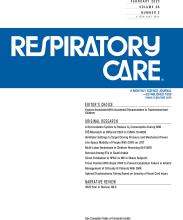This article requires a subscription to view the full text. If you have a subscription you may use the login form below to view the article. Access to this article can also be purchased.
Abstract
Manual and mechanical cough augmentation techniques are used for airway clearance when cough effort is ineffective. Mechanical insufflation-exsufflation (MI-E) has been a mainstay for respiratory complications of neuromuscular disorders, but its use has expanded to other conditions that result in respiratory muscle weakness and impaired cough, such as intubation and mechanical ventilation. Mechanical in-exsufflation has been used for cough augmentation in both adults and children but has been more widely evaluated in adults. Optimal settings for pressure and time are unknown. Newer MI-E devices have the option for oscillatory vibrations during therapy to facilitate secretion clearance. However, use of oscillations is not supported by the available evidence. Pressure settings and the interface used to administer MI-E influence peak expiratory flow generated during therapy. Laryngeal dysfunction can impact successful MI-E treatment in individuals with neuromuscular disorders and bulbar involvement. Transnasal fiberoptic laryngoscopy and videofluoroscopy may be helpful in assessing the laryngeal response and in customizing pressure settings to decrease the incidence of upper airway collapse during therapy. Electrical impedance tomography has been used for monitoring during mechanical ventilation and may have a role in assessing the effectiveness of MI-E. Much of the literature that supports MI-E is derived from small, single-center studies of adult populations. Future study is warranted for efficacy and optimization of MI-E therapy in various clinical applications.
- Cough augmentation
- mechanical insufflation-exsufflation
- cough assistance
- neuromuscular disorder
- invasive mechanical ventilation
- pediatrics
- home care
- laryngeal dysfunction
Footnotes
- Correspondence: L Denise Willis MSc RRT RRT-NPS AE-C FAARC. E-mail: WillisLD{at}archildrens.org
Ms Willis is a section editor for Respiratory Care.
- Copyright © 2023 by Daedalus Enterprises
Pay Per Article - You may access this article (from the computer you are currently using) for 1 day for US$30.00
Regain Access - You can regain access to a recent Pay per Article purchase if your access period has not yet expired.











